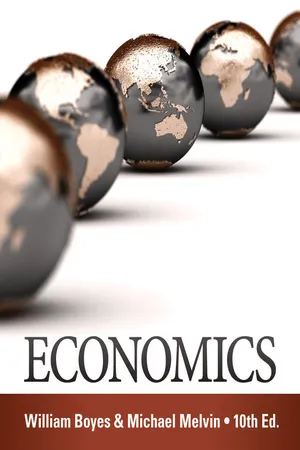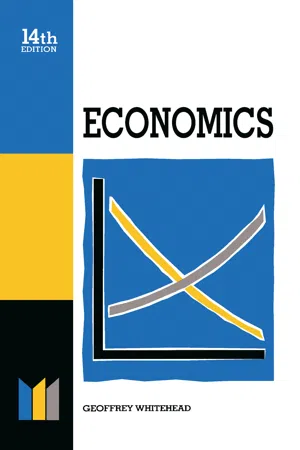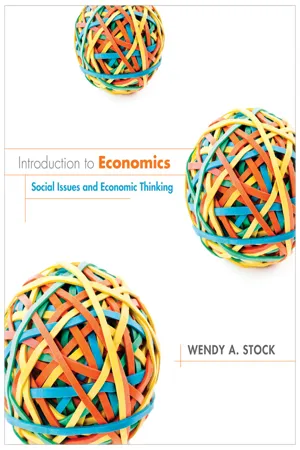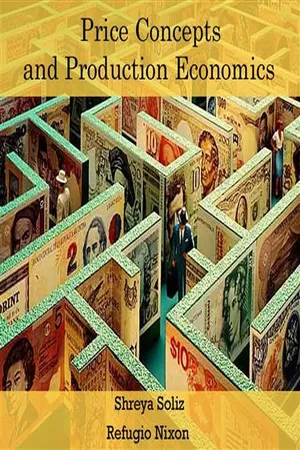Economics
Determinants of Price Elasticity of Demand
The determinants of price elasticity of demand include the availability of substitutes, the necessity of the good, the proportion of income spent on the good, and the time period under consideration. When a good has close substitutes, is a luxury rather than a necessity, represents a large portion of income, or when consumers have more time to adjust their consumption patterns, the demand tends to be more elastic.
Written by Perlego with AI-assistance
Related key terms
1 of 5
12 Key excerpts on "Determinants of Price Elasticity of Demand"
- eBook - PDF
- William Boyes, Michael Melvin(Authors)
- 2015(Publication Date)
- Cengage Learning EMEA(Publisher)
He found that not only had ticket sales declined, but his revenue had fallen as well. Where had the manager gone wrong? 1. How much do buyers alter their purchases in response to a price change? 434 Chapter 20 Elasticity: Demand and Supply Copyright 2016 Cengage Learning. All Rights Reserved. May not be copied, scanned, or duplicated, in whole or in part. Due to electronic rights, some third party content may be suppressed from the eBook and/or eChapter(s). Editorial review has deemed that any suppressed content does not materially affect the overall learning experience. Cengage Learning reserves the right to remove additional content at any time if subsequent rights restrictions require it. 20-1a The Definition of Price Elasticity Elasticity is the measure of the responsiveness of quantity demanded or quantity supplied to a change in price or some other important variable . By “responsiveness” we mean “how much quantity demanded or quantity supplied changes with respect to a change in one variable, everything else held constant.” We have measures of elasticity for both demand and supply. The price elasticity of demand is a measure of the magnitude by which consumers alter the quantity of some product that they purchase in response to a change in the price of that product. The price elasticity of demand, symbolized as e d , is the percentage change in the quan-tity demanded of a product divided by the percentage change in the price of that product. e d ¼ % D Q D % D P The more price-elastic demand is, the more responsive consumers are to a price change—that is, the more they will adjust their purchases of a product when the price of that product changes. Conversely, the less price-elastic demand is, the less responsive consumers are to a price change. Demand curves typically slope down. This means that price ( P ) and quantity ( Q D ) demanded move in opposite directions. Whenever P falls, Q D rises, and when P rises Q D falls. - eBook - PDF
- David Besanko, Ronald Braeutigam(Authors)
- 2020(Publication Date)
- Wiley(Publisher)
You might think that when the price rises, so will the total revenue, but a higher price will generally reduce the quantity demanded. Thus, the “benefit” of the higher price is offset by the “cost” due to the reduction in quantity, and businesses must generally consider this trade-off when they think about raising a price. If the demand is elastic (the quantity demanded is relatively sensitive to price), the quantity reduction will outweigh the benefit of the higher price, and total revenue will fall. If the demand is inelastic (the quantity demanded is relatively insensitive to price), the quantity reduction will not be too severe, and total revenue will go up. Thus, knowledge of the price elasticity of demand can help a business predict the revenue impact of a price increase. DETERMINANTS OF THE PRICE ELASTICITY OF DEMAND Price elasticities of demand have been estimated for many products using statistical techniques. Table 2.1 presents estimates for a variety of food, liquor, and tobacco prod- ucts in the United States; Table 2.2 presents estimates of price elasticities of demand for food products in India, and Table 2.3 presents estimates for various modes of transportation. What determines these elasticities? Consider the estimated elasticity of −0.107 for cigarettes in Table 2.1, which indicates that a 10 percent increase in the total revenue Selling price times the quantity of product sold. L E A R N I N G - B Y- D O I N G E X E R C I S E 2 . 6 Elasticities along Special Demand Curves Problem (a) Suppose a constant elasticity demand curve is given by the formula Q P 200 1 2 . What is the price elasticity of demand? (b) Suppose a linear demand curve is given by the for- mula Q = 400 − 10P. What is the price elasticity of demand at P = 30? At P = 10? Solution (a) Since this is a constant elasticity demand curve, the price elasticity of demand is equal to −1/2 everywhere along the demand curve. - eBook - PDF
Economics
Made Simple
- Geoffrey Whitehead(Author)
- 2014(Publication Date)
- Made Simple(Publisher)
the responsiveness of demand to changes in income; and population Elasticity of Demand and Supply 125 elasticity of demand, i.e. the responsiveness of demand to changes in population. We also have cross elasticities, where a change in the price of one commodity produces changes in the demand for another. Besides price' elasticity of supply it is possible to have factor cost elasticity of supply, the responsiveness of supply to changes in factor prices. 10.2 The Price Elasticity of Demand The price elasticity of demand is the responsiveness of the quantity demanded of a particular good to a small change in its price. If demand responds more than proportionately to a change in price the demand is said to be elastic; if it responds less than proportionately to a change in price it is said to be inelastic. Consider the following examples: (a) Housewives demand potatoes every day, and regard them as a staple diet for the family. Suppose potato prices rise by 10 per cent. Will this cut back demand by 10 per cent? It is unlikely, it might even increase demand, for potatoes are inferior goods. Percentage change in demand say — 1 % 1 Percentage change in price +10% 10 Hence the response of the quantity demanded to the change in price of the good is inelastic, i.e. a less than proportional response. (b) The price of beef rises by 10 per cent. Will housewives cut back on their purchases of beef? Probably they will, for there are several good substitutes, such as lamb and pork. Suppose the demand drops by 25 per cent: Elasticity = — —— = — 2j y + 10% 2 The demand for beef is therefore elastic, i.e. a more than proportional response. (c) The price of lettuces rises by 10 per cent and demand falls by 10 per cent. ™ . . -1 0 % Elasticity = ——-— = — 1 y + 10% The demand for lettuces is said to show unitary elasticity, i.e. the response is exactly proportional to the change in price. The price elasticity of demand is nearly always negative, i.e. - eBook - PDF
Microeconomics
A Contemporary Introduction
- William A. McEachern(Author)
- 2016(Publication Date)
- Cengage Learning EMEA(Publisher)
Chapter 5 Elasticity of Demand and Supply 99 5-2 Determinants of the Price Elasticity of Demand So far we have explored the technical properties of demand elasticity and discussed why it varies along a downward-sloping demand curve. But we have yet to consider why elasticity is different for different goods. Several factors influence the price elastic-ity of demand. 5-2a Availability of Substitutes As we saw in Chapter 4, your particular wants can be satisfied in a variety of ways. A rise in the price of pizza makes other food relatively cheaper. If close substitutes are available, an increase in the price of pizza prompts some consumers to buy substitutes. But if nothing else satisfies quite like pizza, the quantity of pizza de-manded does not decline as much. The greater the availability of substitutes and the more similar these substitutes are to the good in question, the greater that good’s price elasticity of demand. The number and similarity of substitutes depend on how the good is defined. The more narrow the definition, the more substitutes and, thus, the more elastic the demand. For exam-ple, the demand for Post Raisin Bran is more elastic than the demand for raisin bran in general because there are more sub-stitutes for Post Raisin Bran, including Kellogg’s Raisin Bran and Total Raisin Bran, than for raisin bran generally. The demand for raisin bran, however, is more elastic than the demand for breakfast cereals more generally because the consumer has many substitutes for raisin bran, such as cereals made from corn, rice, wheat, or oats, and processed with or without honey, nuts, fruit, or chocolate. To give you some idea of the range of elasticities, the price elasticity of demand for Post Raisin Bran has been estimated to be 2 2.5 versus 2 0.9 for all breakfast cereals. 2 Apple iTunes music downloads fell by 14 percent in 2014, because the company faced stiff competition from free online music videos and from music streaming ser-vices, such as Spotify. - eBook - PDF
Economics
A Contemporary Introduction
- William A. McEachern(Author)
- 2016(Publication Date)
- Cengage Learning EMEA(Publisher)
Chapter 5 Elasticity of Demand and Supply 99 5-2 Determinants of the Price Elasticity of Demand So far we have explored the technical properties of demand elasticity and discussed why it varies along a downward-sloping demand curve. But we have yet to consider why elasticity is different for different goods. Several factors influence the price elastic- ity of demand. 5-2a Availability of Substitutes As we saw in Chapter 4, your particular wants can be satisfied in a variety of ways. A rise in the price of pizza makes other food relatively cheaper. If close substitutes are available, an increase in the price of pizza prompts some consumers to buy substitutes. But if nothing else satisfies quite like pizza, the quantity of pizza de- manded does not decline as much. The greater the availability of substitutes and the more similar these substitutes are to the good in question, the greater that good’s price elasticity of demand. The number and similarity of substitutes depend on how the good is defined. The more narrow the definition, the more substitutes and, thus, the more elastic the demand. For exam- ple, the demand for Post Raisin Bran is more elastic than the demand for raisin bran in general because there are more sub- stitutes for Post Raisin Bran, including Kellogg’s Raisin Bran and Total Raisin Bran, than for raisin bran generally. The demand for raisin bran, however, is more elastic than the demand for breakfast cereals more generally because the consumer has many substitutes for raisin bran, such as cereals made from corn, rice, wheat, or oats, and processed with or without honey, nuts, fruit, or chocolate. To give you some idea of the range of elasticities, the price elasticity of demand for Post Raisin Bran has been estimated to be 22.5 versus 20.9 for all breakfast cereals. - Peter Davis, Eliana Garcés, Eliana Garces-Tolon(Authors)
- 2009(Publication Date)
- Princeton University Press(Publisher)
15,000 cars would be at most 1,000. On the other hand, the same total income divided more equally could certainly generate sales of more than 1,000. (For recent work, see, for example, Lewbel (2003) and references therein.)1.1.2 Demand Elasticities
Elasticities in general, and demand elasticities in particular, turn out to be very important for lots of areas of competition policy. The reason is that the “price elasticity of demand” provides us with a unit-free measure of the consumer demand response to a price increase.7 The way in which demand changes when prices go up will evidently be important for firms when setting prices to maximize profits and that fact makes demand elasticities an essential part of, for example, merger simulation models.1.1.2.1 Definition
The most useful measurement of the consumer sensitivity to changes in prices is the “own-price” elasticity of demand. As the name suggests, the own-price elasticity of demand measures the sensitivity of demand to a change in the good’s own-price and is defined asThe demand elasticity expresses the percentage change in quantity that results from a 1% change in prices. Alfred Marshall introduced elasticities to economics and noted that one of their great properties is that they are unit free, unlike prices which are measured in currency (e.g., euros per unit) and quantities (sales volumes) which are measured in a unit of quantity per period, e.g., kilograms per year. In our example in figure 1.1 the demand elasticity for a price increase of 10 leading to a quantity decrease of 5 from the baseline position, where P = 60 and Q = 20, isηjj= (−5/20)/(10/60) = −1.5.For very small variations in prices, the demand elasticity can be expressed by using the slope of the demand curve times the ratio of prices to quantities. A mathematical result establishes that this can also be written as the derivative with respect to the logarithm of price of the log transformation of demand curve:- eBook - PDF
- David Shapiro, Daniel MacDonald, Steven A. Greenlaw(Authors)
- 2022(Publication Date)
- Openstax(Publisher)
This issue reaches beyond governments and taxes. Every firm faces a similar issue. When a firm considers raising the sales price, it must consider how much a price increase will reduce the quantity demanded of what it sells. Conversely, when a firm puts its products on sale, it must expect (or hope) that the lower price will lead to a significantly higher quantity demanded. 5.1 Price Elasticity of Demand and Price Elasticity of Supply LEARNING OBJECTIVES By the end of this section, you will be able to: • Calculate the price elasticity of demand • Calculate the price elasticity of supply Both the demand and supply curve show the relationship between price and the number of units demanded or supplied. Price elasticity is the ratio between the percentage change in the quantity demanded (Qd) or supplied (Qs) and the corresponding percent change in price. The price elasticity of demand is the percentage 112 5 • Elasticity Access for free at openstax.org change in the quantity demanded of a good or service divided by the percentage change in the price. The price elasticity of supply is the percentage change in quantity supplied divided by the percentage change in price. We can usefully divide elasticities into three broad categories: elastic, inelastic, and unitary. Because price and quantity demanded move in opposite directions, price elasticity of demand is always a negative number. Therefore, price elasticity of demand is usually reported as its absolute value, without a negative sign. The summary in Table 5.1 is assuming absolute values for price elasticity of demand. An elastic demand or elastic supply is one in which the elasticity is greater than one, indicating a high responsiveness to changes in price. Elasticities that are less than one indicate low responsiveness to price changes and correspond to inelastic demand or inelastic supply. Unitary elasticities indicate proportional responsiveness of either demand or supply, as Table 5.1 summarizes. - eBook - PDF
- Steven A. Greenlaw, Timothy Taylor, David Shapiro(Authors)
- 2017(Publication Date)
- Openstax(Publisher)
Recall that quantity demanded (Qd) depends on income, tastes and preferences, the prices of related goods, and so on, as well as price. Similarly, quantity supplied (Qs) depends on factors such as the cost of production, as well as price. We can measure elasticity for any determinant of quantity supplied and quantity demanded, not just the price. Income Elasticity of Demand The income elasticity of demand is the percentage change in quantity demanded divided by the percentage change in income. Income elasticity of demand = % change in quantity demanded % change in income For most products, most of the time, the income elasticity of demand is positive: that is, a rise in income will cause an increase in the quantity demanded. This pattern is common enough that we refer to these goods as normal goods. However, for a few goods, an increase in income means that one might purchase less of the good. For example, those with a higher income might buy fewer hamburgers, because they are buying more steak instead, or those with a higher income might buy less cheap wine and more imported beer. When the income elasticity of demand is negative, we call the good an inferior good. We introduced the concepts of normal and inferior goods in Demand and Supply. A higher level of income causes a demand curve to shift to the right for a normal good, which means that the income elasticity of demand is positive. How far the demand shifts depends on the income elasticity of demand. A higher income elasticity means a larger shift. However, for an inferior good, that is, when the income elasticity of demand is negative, a higher level of income would cause the demand curve for that good to shift to the left. Again, how much it shifts depends on how large the (negative) income elasticity is. Cross-Price Elasticity of Demand A change in the price of one good can shift the quantity demanded for another good. - eBook - PDF
Introduction to Economics
Social Issues and Economic Thinking
- Wendy A. Stock(Author)
- 2013(Publication Date)
- Wiley(Publisher)
SUMMARY In this chapter, we learned about the elasticity of demand, which measures how respon- sive consumers are to changes in the prices of goods and services. When changes in quantity demanded are relatively large in response to price changes, demand is elas- tic. When changes in quantity demanded are relatively small in response to price changes, demand is inelastic. Goods with few substitutes and goods that are neces- sities have relatively inelastic demand. Demand tends to be more elastic for goods when consumers have more time to adjust to price changes and when consumers spend larger fractions of their incomes on the goods. How total revenue responds to price changes is influenced by the elasticity of demand. When the demand for a good is inelastic, sellers can increase total revenue by increasing the price of the good. When demand is elastic, sellers can increase total revenue by decreasing the price of the good. KEY CONCEPTS • Elasticity • Price elasticity of demand • Elastic demand • Inelastic demand • Perfectly inelastic demand • Perfectly elastic demand • Unit elastic demand • Elasticity coefficient • Total revenue K e y C o n c e p t s 9 1 9 2 C H A P T E R 5 E l a s t i c i t y DISCUSSION QUESTIONS AND PROBLEMS 1. Suppose that the adoption fee at the animal shelter is initially $15.00 and the average number of animals adopted per week at that price is 100. In the face of ris- ing costs, there is an increase in the pet adoption fees at the animal shelter from $15.00 to $22.50 (a 50 percent price increase). Proponents of the increase argue that it is necessary to raise revenues for the shelter. Critics of the plan worry that the fee increase might decrease adoptions enough to actually lower shelter revenues. a. What is the revenue earned by the shelter for ani- mal adoptions before the fee increase? b. Suppose animal adoptions fall by 10 percent in response to the 50 percent fee increase (to 90 animals per week). - No longer available |Learn more
- (Author)
- 2014(Publication Date)
- College Publishing House(Publisher)
____________________ WORLD TECHNOLOGIES ____________________ Chapter- 3 Price Elasticity of Demand PED is derived from the percentage change in quantity (%ΔQ d ) and percentage change in price (%ΔP). Price elasticity of demand ( PED or E d ) is a measure used in economics to show the responsiveness, or elasticity, of the quantity demanded of a good or service to a change in its price. More precisely, it gives the percentage change in quantity demanded in response to a one percent change in price (holding constant all the other determinants of demand, such as income). It was devised by Alfred Marshall. Price elasticities are almost always negative, although analysts tend to ignore the sign even though this can lead to ambiguity. Only goods which do not conform to the law of demand, such as Veblen and Giffen goods, have a positive PED. In general, the demand for a good is said to be inelastic (or relatively inelastic ) when the PED is less than one (in absolute value): that is, changes in price have a relatively small effect on the quantity of the good demanded. The demand for a good is said to be elastic (or relatively elastic ) when its PED is greater than one (in absolute value): that is, changes in price have a relatively large effect on the quantity of a good demanded. Revenue is maximised when price is set so that the PED is exactly one. The PED of a good can also be used to predict the incidence (or burden) of a tax on that good. ____________________ WORLD TECHNOLOGIES ____________________ Various research methods are used to determine price elasticity, including test markets, analysis of historical sales data and conjoint analysis. Definition PED is a measure of responsiveness of the quantity of a good or service demanded to changes in its price. - eBook - PDF
Microeconomics
A Global Text
- Judy Whitehead(Author)
- 2020(Publication Date)
- Routledge(Publisher)
The value of the price elasticity of demand depends on: • The availability of substitutes . Demand for a commodity is more price elastic where there are close substitutes. • The extent to which the commodities may be characterized as luxuries or necessities . Luxury goods are more price elastic whereas necessities are more inelastic. • Time period . Demand is more price elastic in the long-run than in the short-run. • Alternative uses . The more alternative uses a commodity has, the greater the price elasticity of demand. C H A P T E R 3 61 MARKET DEMAND AND ELASTICITY C H A P T E R 3 • The proportion of total income spent on the product . The greater the proportion the higher the elasticity. Arc elasticity of demand The above measures of price elasticity of demand refer to what may be called the point elasticity of demand. This is appropriate for small changes in price. For larger changes in price, the formula for arc price elasticity of demand is used. This may be expressed (with the subscript x omitted) as: Q ( P 1 + P 2 ) / 2 η P = · P ( Q 1 + Q 2 ) / 2 3.2.2 The PCC and the price elasticity of demand Price elasticity of demand may be determined from the shape of the price consumption curve ( PCC ). As explained in Chapter 2, the price consumption curve is the line joining successive equilibrium points as the price of good x falls. The price elasticity of demand can be derived from the price consumption curve using money and one good ( x ). The relationship is as follows: • Where η P = 1 in absolute terms (unitary elastic demand), the PCC is a horizontal line. • Where η P < 1 in absolute terms (inelastic demand), the PCC is an upward sloping line. • Where η P > 1 in absolute terms (elastic demand), the PCC is a downward sloping line. Unitary elastic demand Figure 3.2 describes a consumer’s budget line AB and an equilibrium point R on indifference curve IC 1 . Focusing on good x , define good y as the money the consumer can spend on all other goods (except x ). - eBook - PDF
Economics
Theory and Practice
- Patrick J. Welch, Gerry F. Welch(Authors)
- 2016(Publication Date)
- Wiley(Publisher)
53 Demand, Supply, and Price Determination CHAPTER OBJECTIVES Explain how demand and supply work using schedules and graphs. Demonstrate how demand and supply interact in markets to determine prices and to show equilibrium price and quantity, shortages, and surpluses in a market. Explain how changes in nonprice factors cause changes in demand and changes in supply. Illustrate how changes in demand and changes in supply affect equilibrium prices and quantities in markets. Illustrate how government‐imposed price ceilings and price floors influence market conditions. Introduce the concept and calculation of price elasticity, which measures buyers’ and sellers’ sensitivities to price changes. Explain how to measure price elasticity. CHAPTER 3 As we noted in Chapter 2, one way societies can make the basic economic decisions is through individual buyers’ and sellers’ actions in markets. Many societies, such as the United States and some countries in Western Europe and Asia, base their economic systems on such market decision making. There are two basic economic tools to study buyers and sellers and their behaviors in the marketplace: demand and supply. Together these tools help us understand the forces at work in a market economy. In this chapter, we explore demand and supply in detail and put the two together to see how they interact to determine the prices of goods and services. 54 Chapter 3 Demand, Supply, and Price Determination DEMAND AND SUPPLY Demand: The Buyer’s Side Demand, in economic terms, refers to buyers’ plans concerning the purchase of a good or service. For example, you might demand an airplane ticket to London, tennis les- sons, or a chemistry lab book. A business might demand workers, raw materials, machinery, or any other factor of production. Many considerations go into determin- ing the demand for a good or service.
Index pages curate the most relevant extracts from our library of academic textbooks. They’ve been created using an in-house natural language model (NLM), each adding context and meaning to key research topics.











